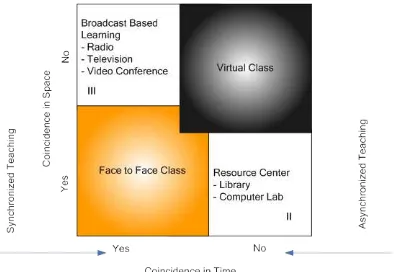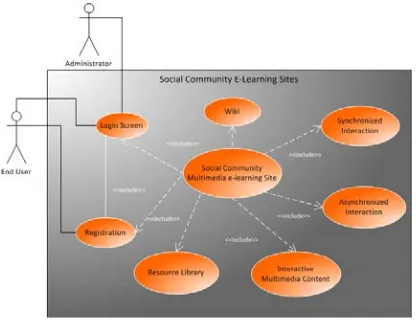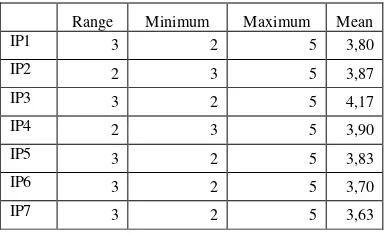311 ISSN 2085-1944
SOCIAL COMMUNITY MULTIMEDIA E-LEARNING SITE
Widyo Nugroho1, Andrisa Prihartana2, Dyah Pratiwi3, Edi Sukirman4,
1,2,3,4
Email: wididaye@yahoo.com
Universitas Gunadarma
1
, andrisa26@gmail.com 2 dpratiwi@staff.gunadarma.ac.id
,
3
Ediskm@staff.gunadarma.ac.id 4.
ABSTRACT
The use of information technology in the area of education plays a major part in today’s learning technology development. Many new revolutionary ways of learning have been invented, thanks to the progress of the information technology. One of them that catches the world’s attention is e-learning technology. The vast growing usage of e-learning has just begun recently, not only educational institutions that are using it, but many companies are also using it to provide trainings for their workforces. What concerns here is, why not e-learning usage be available to anyone in any part of the world where each user can interact an share their knowledge together, and how a social commuity multimedia e-learning can be developed as well as its effectivity in view of its concept within the framework of e-learning evolution.
Using e-learning which is absolutely dependent on the Internet in delivering its content, it is very plausible to implement the concept of social community e-learning site which emphasizes on user interactions rather than one way static content distribution. Many social community sites has been created today, such as friendster and facebook. The idea here is to combine the flexibility of the social community site with the power of e-learning to deliver new revolutionary ways of learning.
The content itself is has to be rich and employs all the media available, so that users can choose what kind of learning materials that are suitable to their needs. In this case the content has to be multimedia in nature. By using multimedia technology very rich and unorthodox learning aids can be delivered to user, and give the users new experience in learning.
Keywords: e-learning, web site, multimedia, social,
community
1
INTRODUCTION
The recent development of e-learning is focusing on the content delivery rather than user involvement and user interaction with the e-learning
system and also with the other users in the learning process. As the first implementation of e-learning, content delivery is the main focus, namely on how learning content can be delivered to users in the internet. This approach has been proven to work well. But the idea of e-learning is more that just content delivery, the way users interact with the content and with the other users becomes the main concern in today’s e-learning development.
The growth of social community networking sites has been high recently after the introduction of friendster and facebook, while the growth of e-learning sites is not as high as those social community sites. The main reason why the development of e-learning sites is still low is that many individuals still think about content delivery rather than social interaction within the e-learning sites. Social interaction has been proven to be so effective to attract users such as in facebook which demonstrated its gain of users. So why can’t e-learning employs the same concept such as social community site to enable user interaction within the e-learning sites?
The content of an e-learning site should also be improved, since the majority of e-learning sites use static contents as their primary learning media, like digital document format, or presentation files. A more comprehensive content model has to be developed to give users more variety of learning media. By using multimedia content, more diverse selection of learning media can be created and delivered to the masses. A social community e-learning along with the multimedia content can be such a powerful means of learning for the masses.
2
MODEL, ANALYSIS, DESIGN,
AND IMPLEMENTATION
2.1
Main Theory
The main theory that is used here is derived from the profile methodology of the e-learning
Figure 1. E-Learning Profile Methodology
As can be seen from the figure 1 there are several ways of learning methodologies. The models on the left side is the conventional ways of learning, such as face to face learning and directed learning. But the models on the right is the more intuitive learning methodology like distant learning and open learning. The social community multimedia e-learning sites is value more on the right, which is the more comprehensive approach but did not deminished the right value which is the more traditional approach. The value on the left is emphasizes on the social interaction juas like the concept of the social community multimedia e-learning sites, but the value on the left is the main concept of learning itself.
The communication on this concept also derived from the time and space dimension of the e-learning.
Figure 2. E-Learning Time and Space Dimension
This models resembles the way a social community multimedia e-learning sites providing means of communication and interaction to its users. The communication is consisting of two different types of communication, the asynchronized models and synchronized models. The asynchronized models is a model which enabled user to communicate without having the other user to participate in the same times, this types of communication can be achieved by using technology such as blogs and wikis or e-mails and forums.
The other way around is the synchronized models, this models is more sophisticated and harder to implement that the asynchronized models. It requires both of the participants to exchange information at the same time. Synchronized models can be achieved by using technologies such as live chat, video conference, and voice conference.
2.2
Conceptual Model
To strengthen the concept of social community multimedia e-learning site, a conceptual model is made. The conceptual model will make the original concept even clearer and more understandable.
Figure 3. Conceptual Model
The model here is simply to put the sites as a center of activity for the users. The model requires that a social community e-learning sites should have several main components that will support the sites.
• User Management: User management is useful in giving the user a profile which they can
costumize to provide more personalized user interface and session for the user when using the sites.
ISSN 2085-1944 sharing, users can also create their very own
learning content.
• Interactive Multimedia Application: This application will be embeded inside the sites to provide the users with an application that would help the learners to learn the subject. Multimedia contents enable the site to deliver much more convenient ways of learning to the users.
• Synchronized Interaction: This interaction provide the users with real-time interaction with each user in the sites. This interaction requires each user to be online at the same time.
• Wiki: This concept is using the already proven online encyclopedia, wiki. Using its costumize device wiki engine the user can get a content and post a content within the internal wiki engine sites.
• Asynchronized Interaction: This type of interaction will provide the sites with one way interaction capability. Users can interact with other users despite the other users are not online at that time.
2.3
Design and Used Technology
The design is derived from the conceptual model. The design is made by using the design tool UML, and resulting in the early design visualized by use case diagram to show each function that are existed within the sites.
Figure 4. Main Design
From figure 4 the main design of the concept is visualized through a use case diagram. Here several use cases have the same function with the conceptual models, except the design has included end user and administrator aspects. The design visualized the core which is the site has seven other
functions that consist within the site, and it is all integrated and embeded in one single site.
The design for the physical implementation is visualized using deployment diagram.
:webserver
Component1
Site
:client
Web Browser
Interaction System Interactive Application
Wiki Resource Library
User Management
Figure 5. Physical Implementation Design
As on the Figure 5, sites will be accessible to clients by using their web browsers. The sites with all their internal functions it is to be hosted at a web server.
A technology that may be used for a social community multimedia e-learning site is not to be restricted to a single technique employment. As web technology grows, the number of techniques that can be used to develop sites also grows. Because a web cannot be built by using a single technique as well as the dynamic nature of webs, it is necessary to collaborate the uses as to when certain technniques should be used properly in order to successfully build a social community e-learning site. There is a huge set of technniques to be selected such as AJAX, XML, XHTML, as well as development languages such as ASP.NET and PHP that can be used to develop a social community e-learning site, not to mention the Adobe Flash and Microsoft Silverlight to add interactive multimedia application to the site
2.4
Early Physical Model
An early physical model was built by using ASP.NET 3.5 for sites and Adobe Flash for multimedia content. The early model only consists of several functions described earlier in the conceptual model, the difference lies in the absence of wiki engine and synchronous interaction, whereas other functions were implemented flawlessly.
2.5
Research Methodology
The subjects of research are the students Gunadarma University. The research instruments are questionaires with Lickert scale measurement, with five scales (1 to 5) namely worst, bad, neutral, good, and best. The aspects of measuremnt are: quality and compatibility, visual quality, content delivery, and user interaction. Data were obtained from the questionaires to be analyzed by using descriptive statistical tests.
2.6
Data Analysis
The test is done to approximately 40 students that randomly picked from Gunadarma University. As listed in table 1, responses for site quality and compatibility are quite good. Each variable has values ranged between 3,23 to 4,13 which are within the scales good and best. Here KK is the label for the variables indicated.
Table 1. Students response on the quality and compatibilty
Range Minimum Maximum Mean
KK1 3 2 5 3,70
KK2 2 3 5 3,80
KK3 2 3 5 3,87
KK4 2 3 5 3,87
KK5 2 3 5 4,00
KK6 2 3 5 4,13
KK7 3 2 5 3,67
KK8 3 2 5 3,87
KK9 3 2 5 3,40
KK10 3 2 5 3,27
KK11 2 3 5 3,73
KK12 2 3 5 4,03
KK13 2 3 5 3,97
KK14 2 2 4 3,23
Visual quality of the sites appears in table 2, the result is outstanding with values ranging from 3,53 to 4,00, which are within the scale best. The boosting factor for this variable is the use of multimedia content possessing better visualization for learning content rather than ordinary documentary. The use of web interface also helped. KT is the label for the indicated variables.
Table 2. Students response on the visual quality.
Range Minimum Maximum Mean
KT1 2 3 5 3,73
KT2 2 3 5 4,00
KT3 2 3 5 3,93
KT4 3 2 5 3,70
KT5 2 3 5 3,97
KT6 2 3 5 3,53
KT7 3 2 5 3,53
Content delivery is described in table 3. The result is interestingly very good where the majority of students responded with values ranging from 3,67 to 4,20 within the scale 1 to 5. This achievement was due to the usage of Adobe Flash multimedia application for learning content which give the user more interactivity with the content. PM is the label for the indicated variables.
Table 3. Students response on the visual quality
Range Minimum Maximum Mean
PM1 2 3 5 3,90
PM2 3 2 5 3,70
PM3 2 3 5 3,87
PM4 2 3 5 3,90
PM5 2 3 5 3,87
PM6 2 3 5 3,97
PM7 2 3 5 3,67
PM8 2 3 5 4,20
User interaction is described in table 4. The result is suprisingly very good with the majority of students responded with values ranging from 3,63 to 4,17 within the scale of to 1 to 5, thanks to the concept of social community interaction within the site and the use of multimedia content. IP is the label for the indicated variables.
Table 4. Students response on the user interaction
Range Minimum Maximum Mean
IP1 3 2 5 3,80
IP2 2 3 5 3,87
IP3 3 2 5 4,17
IP4 2 3 5 3,90
IP5 3 2 5 3,83
IP6 3 2 5 3,70
ISSN 2085-1944
The results of a social community multimedia e-learning site concept are guidelines for those who want to build such sites. The concept itself is proven to be hard to achieved in real world, but is possible to built using the existing technology, many Content Management Systems already shows that’s such a concept can be made to reality with ease. But the concept of social community multimedia e-learning site had several advantages and constraints. The advantages for this concept are.
• Available To All: By using the power of internet websites it is accessible all over the world as long as one is connected to the Internet and no matter what device one uses.
• Platform Flexibility: A website is accessible no matter what operating system or device is employed because web has open standard and cross platform compatible.
• Powerful Means of Learning: By harnessing the power of the Internet, the concept of social community based e-learning will evolve as an alternative learning method.
• Diversity in Content: Using multimedia technology, users can choose whatever kind of learning media suitable for their needs.
• Better User Interaction: With the use of social community site for e-learning, users can interact with each other on the site.
• Better Knowledge Sharing: Social communtiy implementation also gives advantages for far better knowledge sharing than conventional content delivery.
• Better Interactivity: The use of multimedia content has been proven to be useful for adding more interactivity between user and content. Despite of all this advantages and despite the research that was done with the early physical models indicated good, there are several constraints in the realization of the concept.
• Technology Diversity: Vast number of internet and web technologies can give the developer many selection of tools but also development challenges.
• Browser Incompatibility: This is proven to be a major problem of website. Incompatibility
between the browsers has proven to be devastating.
• Improper Content Material: Very large numbers of users submitting and sharing their knowledge within the sites can be troublesome to filter proper user content.
• User Management: Management of user within the site where the user can share their knowledge and communicate each other is a challanging task. Many problem will occur and even more problems will come up as the number of users grows.
Development Challenges: The development of this concept is not an easy process, because it deals with many technologies and diverse fields of study, information technology, communication, and education technology. It requires joint forces to develop the concept
4
CONCLUSION AND DISCUSSION
This concept of social community multimedia e-learning site needs further researches or even tests, so that the concept can evolve as an actual implementations based concept and can be used effectively as alternative ways of learning. The conceptual model is suitable for implementing the theoretical concepts in view of good feed back of the early physical model provided by the students. But it is still based on a rather insufficient sample of early physical model and conceptual models. Further research and development of an implementable ideal physical models is required to gain more actual benefits and to know more of the challanges for the concept so that the know-how of the concept has to be developed can be well improved.
REFERENCES
[1] Adams B, Alden J, and Harris N (2006) Regional development and spatial planning in an enlarged European Union. Aldershot: Ashgate.
[2] Ang L, and Taylor B (2005) Managing customer profitability using portfolio matrices. Journal of Database Marketing and Customer Strategy Management 12: 298-304.
Greenwich Medical, pp. 225-239.
[4] Benoit B (2007) G8 faces impasse on global warming. Financial Times 29 May 2007, p. 9. [5] European Commission (2004) First report on
the implementation of the internal market strategy 2003-2006. Luxembourg: Office for Official Publications of the European Communities.
[6] Fledelius H C (2000) Myopia and significant visual impairment: global aspects. In: Lin L L-K, Shih Y-F, and Hung P T [eds.] Myopia Updates II: Proceedings of the 7th International Conference on Myopia. Taipei, 17-20 November, 1998. Tokyo: Springer, pp. 31-37.
[7] Garcia-Sierra A (2000) An investigation into electronic commerce potential of small to medium-sized enterprises. PhD Thesis, Cardiff University.
[8] Thompson B (2006) Why the net should stay neutral [Online]. Available at: [Accessed: 10 May 2007].
[9] Kyle L.Peck , Michael J.Hannafin ( 1988) The design, Development, and Evaluation of Instructional software.Macmillan Publsing company,
[10] Stanley R.Trollip and Stehen M. Alessi, Computer – based Instruction methods and development, (1991), Prentice Hall, Englewood Cliffs, NewJersey.


